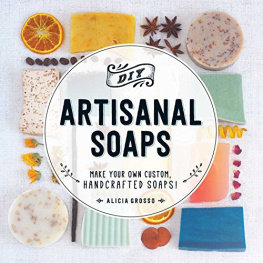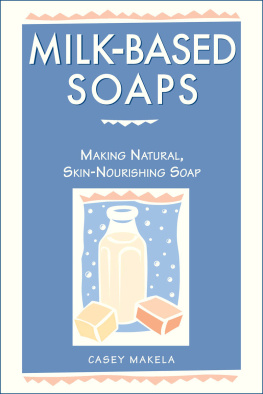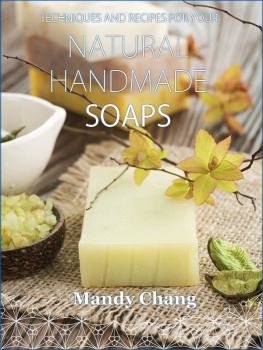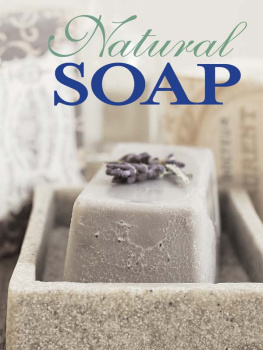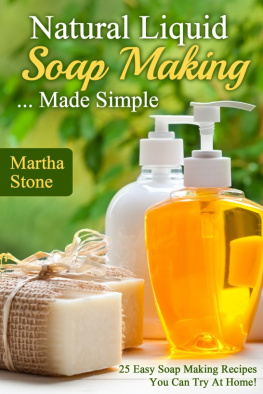Thank you for downloading this Simon & Schuster ebook.
Get a FREE ebook when you join our mailing list. Plus, get updates on new releases, deals, recommended reads, and more from Simon & Schuster. Click below to sign up and see terms and conditions.
CLICK HERE TO SIGN UP
Already a subscriber? Provide your email again so we can register this ebook and send you more of what you like to read. You will continue to receive exclusive offers in your inbox.
DIY ARTISANAL SOAPS
Make Your Own Custom, Handcrafted Soaps!
ALICIA GROSSO

Avon, Massachusetts
CONTENTS
Chapter One
WHAT YOULL NEED
Chapter Two
HOW TO GET STARTED
Chapter Three
COLD-PROCESS SOAPMAKING
Chapter Four
COLD-PROCESS RECIPES
Chapter Five
HOT-PROCESS SOAPMAKING
Chapter Six
HERBS YOU CAN PUT IN YOUR SOAP
Chapter Seven
FRAGRANCES YOU CAN PUT IN YOUR SOAP
Chapter Eight
ESSENTIAL OILS YOU CAN PUT IN YOUR SOAP
Chapter Nine
COLOR FOR YOUR SOAP
Chapter Ten
LIQUID AND CREAM SOAPS
Chapter Eleven
HOW TO CAST SOAP
Chapter Twelve
SOAP-CASTING PROJECTS
Chapter Thirteen
HOW TO HAND MILL YOUR SOAP
Chapter Fourteen
MAKE YOUR OWN RECIPES
Chapter Fifteen
PRESENTING AND GIFTING YOUR SOAP
Appendix A
SOAPMAKING RESOURCES
Appendix B
MAKING MOLDS AND CUTTERS
INTRODUCTION
Soaps filled with basil, lavender, or lemon verbena that youve grown in your garden. Soaps scented with essential oils such as oakmoss, rose, or tea tree, picked up at your local market. Soaps striped in scarlet, indigo, and gold that bring the vibrant colors of the farmers market into your home.
DIY Artisanal Soaps will teach you everything you need to know to join the community of soapmakers across the country. In doing so, youll find that this simple household substance will gain a completely new meaning for you. Your soaps will be filled with ingredients youve found or purchased at local markets and stands, ranging from beeswax to bacon, mango butter to soy oil. Youll find yourself searching through your pantry, garden, and local farm produce stands for plants, oils, and fruits you can put into your soaps. Youll search for molds and tools to shape your bars in countless creative ways. And youll learn how to make bar and liquid soaps, cold- and hot-process soaps, and hand-milled soaps safely and easily in the comfort of your own kitchen.
Homemade soap has these benefits:
Its natural. Homemade artisan soap isnt something thats churned out of a factory, chock-full of potentially harmful chemicals. You make it with natural ingredients that youve chosen. After all, you know whats best for you and your family. You can avoid anything to which youre allergic and focus on those substances you enjoy most.
Its creative. Making soap means more than just following a series of steps in a recipe book. Its finding new ways of creating something that smells great and looks inviting. Soapmaking, as many have found, is a way to express yourself as you dream up new recipes and mold the soap into innovative forms.
Its energizing. Handmade soap makes you feel good because it reminds you that you made it. As you soak in a bath or stand in the shower, youll enjoy using something thats the product of your vision and creativity. Youll enjoy combining different ingredients in your soaps, experimenting with fragrances, colors, and textures until you discover just the right one for you.
Soapmaking is a way of using natural ingredients to create an item that you both love and love to use. In fact, youll soon find that you love this creative process so much that youll want to share your artisanal soaps with others, which is why youll find suggestions throughout the book on how to lovingly prepare your products for gifting, sharing, and selling. So start experiencing the home-grown pleasures of soapmaking, and bring the scents of farm and garden into your own home.
SAFETY NOTE
Soapmaking at home can be hazardous. Heat and caustics are the primary potential dangers. If you fear that you cannot sufficiently control your surroundings to keep and use soapmaking materials safely, do not make soap at home. However, soap is made without accident every day by thousands of home soapmakers. The basic safety gear youll need is eye protection, gloves, protective mitts, a painters paper dust mask or filter mask, a fire extinguisher, and vinegar.
Eye Protection
Internet soapmaking-supply houses and hardware stores stock a variety of eye protection products. Make sure that the eye protection you use is resistant to impact, caustics, and heat. If you wear glasses, get goggles that are large enough to wear over them. Be particular as you shop for eye protection. Never take chances with the health and safety of your eyes.
The danger to your eyes comes from the potential of lye particles, lye solution, raw soap, hot oils, and other liquids splashing you in the face. In methods that do not use caustics to create soap, the potential hazards are hot melted soap and steam. As long as you work mindfully, you will experience very fewif anysplashing events. However, you do not want to be caught unprotected if one should occur.
At the very least, caustics will cause surface irritation to the skin on your face. At the worst, you can be blinded if you splash lye solution in your eyes. Be sure to have an emergency plan just in case an accident should happen.
Gloves and/or Protective Mitts
Regular rubber kitchen gloves provide appropriate protection for your hands and lower arms. Make sure the gloves you buy have textured fingers so that you can keep a firm grip on your equipment. Some soapmakers prefer heavy-duty gloves. Just be sure you can use your fingers freely.
Thin examination gloves are sufficient for handling partly cured soap. You can find these in the pharmacy section of a mass-market store and at drugstores. If you are sensitive to latex, you can buy gloves made from thin vinyl. Check your gloves regularly for holes and splits. Replace them before you need to.
When you are finished with your soapmaking project for the day, clean your gloves well with soap and water. If you clean them and dry them, theyll last quite some time. Turn them inside-out to dry and store them only after theyre completely dry.
Be sure to protect your arms above the gloves with a long-sleeved shirt. An oversized button-up shirt with sleeves you can roll up is ideal.
Remember that youre not going to go around carelessly splashing lye. You will have everything prepared so you wont be running here and there, dripping caustics and hot soap around. Just use common sense and be sure you protect yourself and household surfaces.
You should also have some heavy-duty oven mitts handy for lifting hot containers from the stove or other surfaces. Be sure to clean them regularly, since they can quickly build up soap components.
Painters Paper Dust Mask or Filter Mask
If youre making soap with lye, it can cause dangerous fumes. Usually it is enough just to stand back and not breathe the fumes, but if you are concerned about sensitivity to them, wear a painters paper dust mask or filter mask over your mouth and nose.
Fire Extinguisher
Whenever you are working with a stove, hotplate, or other heat source, you need to have a fire extinguisher within easy reach. Make sure your fire extinguisher is charged and ready to go. The time you need the fire extinguisher is not the time to wonder where it is or if its charged. Read the instructions so that you know how to use it. Also be sure to review basic kitchen safety procedures. For example, you would never throw water on an oil fire, and you would always use protective mitts when handling hot pans and utensils.
Next page
